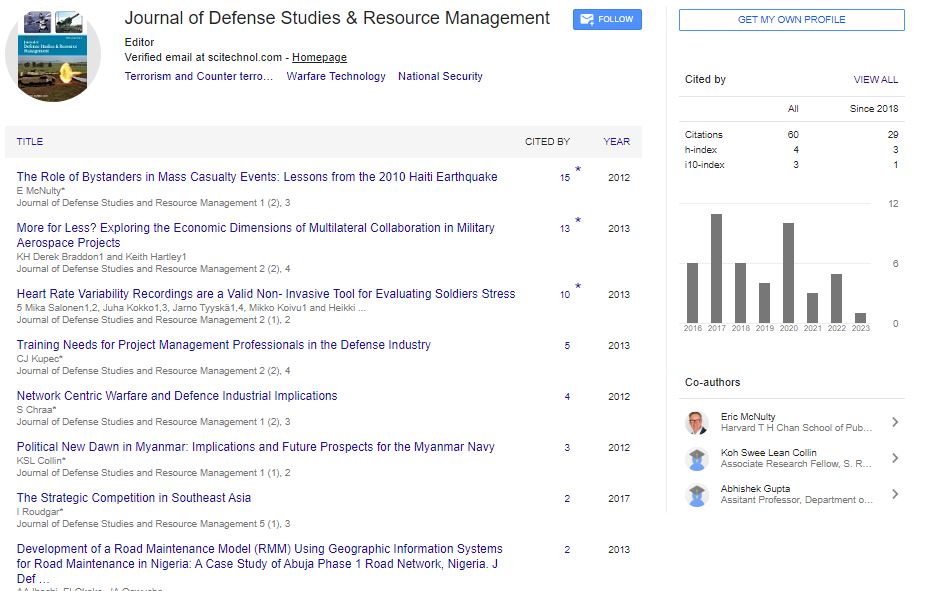Perspective, J Def Stud Resour Manage Vol: 11 Issue: 4
Analyzing the Far-Reaching Effects of Chemical Warfare
Ruotong Radlinska*
1Department of Hydrobiology, Institute of Functional Biology and Ecology, University of Warsaw, Warsaw, Poland
*Corresponding Author: Ruotong Radlinska,
Department of Hydrobiology,
Institute of Functional Biology and Ecology, University of Warsaw, Warsaw,
Poland
E-mail: ruotong05@gmail.com
Received date: 30 October, 2023, Manuscript No. JDSRM-23-123193;
Editor assigned date: 01 November, 2023, PreQC No. JDSRM-23-123193 (PQ);
Reviewed date: 16 November, 2023, QC No. JDSRM-23-123193;
Revised date: 23 November, 2023, Manuscript No. JDSRM-23-123193 (R);
Published date: 30 November, 2023, DOI: 10.4172/ 2324-9315. 1000196
Citation: Radlinska R (2023) Analyzing the Far-Reaching Effects of Chemical Warfare. J Def Stud Resour Manage 11:4.
Abstract
The chemical weapons represent a dark chapter, where the brutality of conflict takes on an insidious and indiscriminate form. The use of chemical warfare, involving the deployment of toxic substances to harm or kill living organisms, has left a haunting legacy with severe consequences for both immediate victims and the environment. Chemical warfare has a sinister history that dates back to World War I, where it was first employed on a large scale.
Description
The chemical weapons represent a dark chapter, where the brutality of conflict takes on an insidious and indiscriminate form. The use of chemical warfare, involving the deployment of toxic substances to harm or kill living organisms, has left a haunting legacy with severe consequences for both immediate victims and the environment. Chemical warfare has a sinister history that dates back to World War I, where it was first employed on a large scale. The use of chlorine and mustard gas in the trenches marked a departure from traditional warfare tactics and introduced a new level of horror. Since then, various conflicts have seen the deployment of chemical agents, including nerve gases, blister agents, and choking agents.
Types of chemical agents and consequences
These compounds disrupt the transmission of nerve impulses, leading to paralysis and, in severe cases, death. Sarin and VX are examples of nerve agents. Substances like Sulphur, mustard cause severe chemical burns and blistering on the skin and respiratory tissues. Agents like chlorine and phosgene irritate the respiratory system, causing coughing, difficulty breathing, and, in extreme cases, suffocation. These agents interfere with the body's ability to transport oxygen. Hydrogen cyanide is an example of a blood agent. The consequences of chemical warfare on human populations are devastating and extend far beyond the immediate casualties on the battlefield. Exposure to chemical agents can lead to acute and chronic health effects, depending on the type and intensity of exposure. Victims may experience respiratory distress, burns, blindness, and, in severe cases, death shortly after exposure. Survivors of chemical attacks often suffer from long-term health issues, including respiratory problems, neurological disorders, and an increased risk of cancer.
Chemical attacks inflict not only physical but also psychological trauma on survivors. The fear and trauma associated with the use of chemical weapons can leave lasting scars on individuals and communities. The use of chemical weapons also wreaks havoc on the environment, affecting ecosystems and potentially causing longlasting damage. The release of toxic chemicals into the air, water, and soil can contaminate food sources, harm wildlife, and persist in the environment for extended periods. Chemical agents can seep into the soil, affecting plant growth and rendering large areas uninhabitable for extended periods. Disposal of chemical weapons or their runoff can contaminate water sources, affecting aquatic life and posing risks to human communities that rely on these water bodies. The introduction of toxic substances can disrupt entire ecosystems, leading to declines in biodiversity and the long-term degradation of natural habitats.
International response and treaties
Recognizing the catastrophic consequences of chemical warfare, the international community has taken steps to curb its use. The Chemical Weapons Convention (CWC), established in 1997, is a landmark arms control treaty that prohibits the development, production, acquisition, stockpiling, and use of chemical weapons. The Organization for the Prohibition of Chemical Weapons (OPCW) oversees the implementation of the CWC and works to verify and enforce compliance among member states. Despite international efforts to eliminate chemical weapons, challenges persist. Non-state actors, terrorist organizations, and rogue states may still pose a threat by developing or acquiring chemical weapons. The potential for the use of chemical agents in conflicts remains a sobering reality, demanding continued vigilance and cooperation among nations.
Conclusion
Chemical warfare stands as a dark and brutal chapter in the history of conflict, leaving a trail of suffering and environmental devastation. The use of chemical weapons not only inflicts immediate harm on those directly affected but also leaves a legacy of long-term health issues and environmental damage. The international community's commitment to arms control and disarmament, as embodied in the Chemical Weapons Convention, represents a collective effort to prevent the horrors of chemical warfare and protect the well-being of humanity and the planet. As the world grapples with ongoing threats and challenges, the need for continued vigilance and cooperation in the face of this toxic menace remains paramount.
 Spanish
Spanish  Chinese
Chinese  Russian
Russian  German
German  French
French  Japanese
Japanese  Portuguese
Portuguese  Hindi
Hindi 